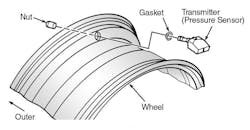SUBJECT VEHICLE: 2003-07 Infiniti FX35
RELEARN PROCEDURE? No.
SPECIAL TOOLS NEEDED? Yes, Nissan CONSULT-II and CONSULT-II CONVERTER
The tire pressure monitoring system (TPMS) on 2003-07 Infiniti FX35s works during driving at speeds above 20 mph, when the low tire pressure warning system receives the signal transmitted from the transmitter installed in each wheel. When the low tire pressure warning system detects low inflation pressure or another unusual symptom, the warning light in the instrument cluster comes on.
A sensor-transmitter integrated with a valve (installed on each wheel) transmits a detected air pressure signal in the form of a radio wave. The remote keyless entry receiver receives the air pressure signal transmitted by the transmitter in each wheel.
The Body Control Module (BCM) reads the air pressure signal received by the remote keyless entry receiver, and controls the warning light and the buzzer operations.
It also has a judgment function to detect a system malfunction.
To remove an old sensor, follow these steps.
1. Deflate the tire. Unscrew the transmitter retaining nut, and allow the transmitter to fall into the tire.
2. Gently bounce the tire so that the transmitter falls to the bottom of the tire. Place the wheel and tire assembly on the tire changing machine and break both tire beads. Ensure that the transmitter remains at the bottom of the tire while breaking the bead.
3. Turn the tire so that the valve hole is at the bottom, and gently bounce the tire to ensure the transmitter is near the valve hole. Carefully lift the tire onto the turntable, and position the valve hole (and transmitter) 270 degrees from the mounting/demounting head.
4. Lubricate the tire well, and remove the first side of the tire. Reach inside the tire and remove the transmitter (see Figure 1).
5. Remove the second side of the tire as normal.
To install a new sensor, follow these steps.
1. Place the first side of the tire onto the rim. NOTE: After every disassembly, use a new seal on the tire pressure sensor.
2. Mount the transmitter on the rim and tighten the nut to 61 to 72 in.-lbs. for 2003-06 models or 66 in.-lbs. for 2007 models. NOTE: Do not touch the transmitter with the mounting head.
3. Place the wheel on the turntable of the tire machine. Ensure that the transmitter is 270 degrees from the mounting/demounting head.
4. Lubricate the tire well, and install the second side of the tire as normal. Ensure that the tire does not rotate relative to the rim.
5. Inflate the tire. Balance the wheel and tire assembly.
6. Install the wheel and tire assembly in the appropriate wheel position on the vehicle.
7. Ensure the front wheel alignment is correct. To adjust the neutral position of the steering angle sensor, turn the tires straight ahead and ensure the steering wheel is in the neutral position. If it is not in neutral, go to the next step.
[PAGEBREAK]
8. Remove the steering wheel and reinstall it correctly. If the neutral position cannot be attained by repositioning the steering wheel two teeth or less on the steering stem, loosen the tie-rod lock nuts of the steering outer sockets, and then adjust the tie rods by the same amount in the opposite direction.
9. Register the tire pressure sensor.
To reset a new sensor and register it, follow these steps. NOTE: To register a new tire pressure sensor, a Nissan CONSULT-II and CONSULT-II CONVERTER must be used. A Transmitter Activation Tool (J-45295) can aid in the registration procedure.
If CONSULT-II is used with no connection of CONSULT-II CONVERTER, malfunction might be detected during self-diagnosis depending on the control unit which carries out CAN communication.
ID registration with transmitter activation tool
1. With the ignition switch in the OFF position, connect CONSULT-II and CONSULT-II CONVERTER to the Data Link Connector (DLC). Turn the ignition switch to the ON position.
2. Select “START (Nissan-based VHCL)”.
3. Touch “BCM” on the “Select System” screen.
4. Select “Air pressure monitor” on the “Select work item” screen.
5. Select “Work support” on the “Select Diag Mode” screen, and select “ID Regist.”
6. With the Transmitter Activation Tool (J-45295) pushed against the front left transmitter tire air valve, press the button for five seconds.
7. Register the IDs in the specified order. When the ID registration of each wheel has been completed, a buzzer sounds as indicated and the turn signal lights blink.
Be sure to register the IDs in the specified order, or the self-diagnostic results display will not function properly.
8. After completing all ID registrations, press “end” to complete the procedure.
ID registration without transmitter activation tool
1. With the ignition switch in the OFF position, connect the CONSULT-II and CONSULT-II CONVERTER to the DLC. Turn the ignition switch to the ON position.
2. Select “Start (Nissan Based VHCL)”.
3. Touch “BCM” on the “Select System” screen.
4. Select “Air Pressure Monitor” on the “Select Work Item” screen.
5. Select “Work Support” on the “Select Diag Mode” screen, and select “ID Regist.”
6. Adjust tire pressure to the specified values for ID registration, and drive the vehicle at 25 mph or more for a few minutes.
7. After completing all ID registrations, press “END” to complete the procedure.
8. Inflate all tires to specification.
Transmitter wake-up operation
1. With the Transmitter Activation Tool pushed against the front-left transmitter, press the button for five seconds. With the ignition switch in the ON position, as the warning light flashes the respective transmitter then must be woken up.
2. Register the ID of the wheel that the warning lamp flashes for. When wake-up of the registered wheel has been completed, the signal light flashes two times.
3. After completing the wake up of all the transmitters, make sure the low tire pressure warning light goes out. ■
Information for this column comes from Mitchell 1’s ”Tire Pressure Monitoring Systems Guide” for domestic and import vehicles through 2010. Headquartered in Poway, Calif., Mitchell 1 has provided quality repair information solutions to the automotive industry for more than 80 years. For more information, visit www.mitchell1.com.
More TPMS articles:




